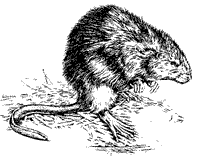|
Muskrats | Muskrat Overview | Muskrat Damage Assessment | Muskrat Damage Management | Muskrat Resources | Muskrat Acknowledgments | ICWDM | Wildlife Species Information |
Damage and Damage Identification

Damage caused by muskrats is primarily due to their burrowing activity. Burrowing may not be readily evident until serious damage has occurred. One way to observe early burrowing in farm ponds or reservoirs is to walk along the edge of the dam or shorelines when the water is clear and look for “runs” or trails from just below the normal water surface to as deep as 3 feet (91 cm). If no burrow entrances are observed, look for droppings along the bank or on logs or structures a muskrat can easily climb upon. If the pond can be drawn down from 1 1/2 to 3 feet (46 to 91 cm) each winter, muskrat burrows will be exposed, just as they would during extended drought periods. Any burrows found in the dam should be filled, tamped in, and covered with rock to avoid possible washout or, if livestock are using the pond, to prevent injury to a foot or leg.
Where damage is occurring to a crop, plant cutting is generally evident. In aquaculture reservoirs generally maintained without lush aquatic vegetation, muskrat runs and burrows or remains of mussels, crayfish, or fish along with other muskrat signs (tracks or droppings) are generally easy to observe.
Legal Status
Muskrats nationwide for many years were known as the most valuable furbearing mammal, not in price per pelt, but in total numbers taken. Each state fish and wildlife agency has rules and regulations regarding the taking of muskrats. Where the animal causes significant economic losses, some states allow the landowner to trap and/or use toxic baits throughout the year. Other states prohibit taking muskrats by any means except during the trapping season. Check existing state wildlife regulations annually before attempting to remove muskrats.
Economics of Damage and Control
Assessment of the amount of damage being caused and the cost of prevention and control measures should be made before undertaking a control program. Sometimes this can be easily done by the landowner or manager through visual inspection and knowledge of crop value or potential loss, and reconstruction or replacement costs. Other situations are more difficult to assess. For example, what is the economic value of frustration and loss of a truckload of minnows and/or fish after a truck has fallen through the levee into burrowed-out muskrat dens? Or how do you evaluate the loss of a farm pond dam or levee and water behind it from an aquaculture operation where hundreds of thousands of pounds of fish are being grown? Rice farmers in the mid-South or in California must often pump extra, costly irrigation water and shovel levees every day because of muskrat damage. The expense of trapping or other control measures may prove cost-effective if damage is anticipated. Obviously, the assessments are different in each case. The estimate of economic loss and repair costs, for example, for rebuilding levees, replacing drain pipes, and other measures, must be compared to the estimated cost of prevention and/or control efforts.
Economic loss to muskrat damage can be very high in some areas, particularly in rice and aquaculture producing areas. In some states damage may be as much as $1 million per year. Totals in four states (Arkansas, California, Louisiana, and Mississippi) exceed losses throughout the rest of the nation.
Elsewhere, economic losses because of muskrat damage may be rather limited and confined primarily to burrowing in farm pond dams. In such limited cases, the value of the muskrat population may outweigh the cost of the damage.
Muskrat meat has been commonly used for human consumption and in some areas called by names, such as “marsh rabbit.” A valuable resource, it is delicious when properly taken care of in the field and in the kitchen. Many wild game or outdoor cookbooks have one or more recipes devoted to “marsh rabbit.” Care should be taken in cleaning muskrats because of diseases mentioned earlier.
Muskrat pelts processed annually are valued in the millions of dollars, even with low prices; thus the animal is certainly worthy of management consideration. It obviously has other values just by its place in the food chain.
|
Muskrats | Muskrat Overview | Muskrat Damage Assessment | Muskrat Damage Management | Muskrat Resources | Muskrat Acknowledgments | ICWDM | Wildlife Species Information |
